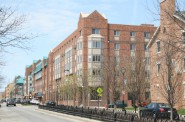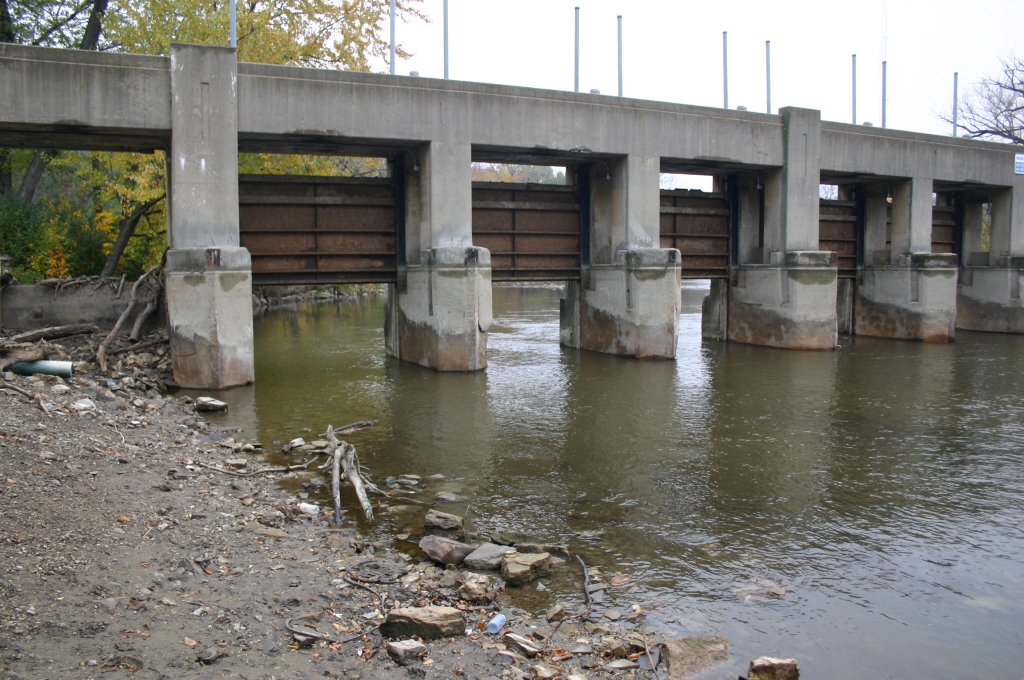Don’t Repair the Estabrook Dam
Taking issue with Urban Milwaukee's series. First of two parts.
Removing the Milwaukee River Estabrook Dam is the most cost-effective and environmentally sound dam management alternative. That was the conclusion Milwaukee County’s consultant AECOM came to in a detailed 2015 environmental assessment. AECOM’s comprehensive assessment studied the socio-economic and environmental benefits and costs associated with repairing or removing the dam, and a number of other alternatives that were developed as potential compromises to accommodate the concerns of dam repair and removal proponents. Several public meetings were held over the last few years, and the public weighed in with support for dam removal. In addition, the cities of Milwaukee and Shorewood and the Milwaukee Metropolitan Sewerage District (MMSD) have all passed resolutions in support of dam removal.
It is unfortunate that Supervisor Theodore Lipscomb, Sr., who was present at early meetings for the County’s own expert assessment and had ample opportunity to review the assessment, failed to offer it to the full County Board for review and debate after public hearings in 2014 and after the draft environmental assessment was issued in summer 2015. In fact there has never been a standalone up or down vote at the Milwaukee County Board level based on the independent merits of this issue. This simple act could have avoided the political gamesmanship that followed, where the County’s policy was changed from repair, to removal, and then back to repair with fish passage through several budget cycles in 2014-2016 using questionable methods.
Some of the information cited by David Holmes from the draft September 2014 Environmental Assessment (EA) is outdated (e.g., dam management costs). Unfortunately, even the most recent EA must go through yet another revision because of the County Board’s change in policy to add fish passage to the repair of the dam, and to comply with the DNR’s requirement to establish an Operational Order for operating and maintaining the dam and fishway, and setting water levels that are protective of the public interest and the environment. A Public Hearing is tentatively planned in March 2016. I encourage all interested residents to follow and participate in the process and review the most recent October 2015 environmental assessment.
Milwaukee County’s current policy to repair the Milwaukee River’s Estabrook Dam and to construct an engineered fish passage facility around it should be postponed. The County should appoint an ad hoc committee of scientists and other independent professionals to review the existing information and provide recommendations that benefit the entire stakeholder group. Scientists and engineers from local universities and colleges, and water resource management agencies with expertise in surface water resource studies and management should be asked to participate on the committee. An alternative can be identified that mitigates the severe historical environmental impacts of deepening and widening of the river channel for 1.5 miles and the construction and operation of the Estabrook Dam. Unlike the dam repair with fish passage alternative, there are alternatives that are less costly, more sustainable, approach the historic functions and uses of the Milwaukee River, and do not increase potential flood and drainage damages. As in the past, the findings and recommendations should be presented to the public for review and input. Supervisor Lipscomb, as well as proponents and opponents to repairing the dam, should accept those recommendations as expertly informed and follow them without political maneuvering. What could be more responsible than that? After all is said and done, the ultimate decision on the fate of the Estabrook Dam will affect existing and future generations and will dramatically influence hundreds of square miles within the Milwaukee River and Lake Michigan Basins, an area dwarfing the confines of the 103-acre impoundment. It’s important the County and its residents make that decision based on the best information available.
That said, here is some of my relevant background. I am a former water resources and fisheries biologist with the Wisconsin Department of Natural Resources (DNR) having retired in July 2015 after 38 years with the agency. My experience as it relates to the Estabrook Dam included working with over 15 dam owners and stakeholders to assess dam management alternatives in the Milwaukee River Basin, the pre- and post-monitoring of those projects, as well as assisting with the design of fish passage features including the fishways at the Mequon-Thiensville Dam on the Milwaukee River and several projects along the Menomonee River. I was also the local DNR project manager for the $4.7 million North Avenue Dam removal completed by the City of Milwaukee in 1997, and was also involved with the initial assessment that identified the extent of sediment accumulation and PCB contamination in the Milwaukee River’s Estabrook Dam impoundment. I am a long-time, taxpaying resident of Milwaukee County and deeply care for what is best for the long-term uses and values of the Milwaukee River.
The following is a very brief summary of a longer and more in-depth analysis with exhibits and links regarding the future state of the Estabrook Dam and impoundment, which can be found here. I would appreciate your review of the larger document and offer your comments by way of this article.
What was the Milwaukee River’s historic morphology? Drainage Lake or River?
Mr. Holmes and supporters for repair of the dam argue that keeping the Estabrook Dam restores the “…unique hydrologic feature – a drainage lake that appears to have existed in the area of Lincoln Park since before the end of the Wisconsin glaciation.” Firstly, the historic river morphology that surrounded the area is not unique to the Milwaukee River watershed. There are numerous examples of similar river reaches in Milwaukee, Ozaukee and Washington Counties, some have been altered and others remain in a relatively natural state. Secondly, by many abiotic or biotic measures, the pre-European settlement of the Milwaukee River surrounding the Estabrook Dam and its impoundment was riverine and supported river ecological functions and values. This is borne out by Milwaukee County’s GIS-based 1937 aerial photographs that were taken while half of the river channel modifications downstream of Hampton Ave. were still under construction, and prior to constructing the dam and the river “center-cut” upstream of Hampton Ave., as well as from historic planning documents.
Prior to the 1930’s lowering of the rock outcrop and construction of the 0.4 mile long “center cut” between Hampton Avenue and the upper confluence of the present day “east and west oxbows”, the Milwaukee River was a low-gradient, meandering alluvial river channel dominated by pool and run features. Its immediate corridor and broad floodplain included over 100-acres of floodplain wetlands that supported habitat for a diverse plant and animal community sustained by seasonal flood waters that deposited nutrient-laden sediment. The top of the bank was reported to be only 2-feet from the normal (base-flow) water surface suggesting the entire river valley was inundated during frequent floods. The flood waters likely extended upstream into additional wetlands along “Mud Creek” (present day Lincoln Creek).

1937 aerial photograph showing historic meander of the Milwaukee River in Lincoln Park prior to construction of the Estabrook Dam and 3,000-ft long by 200-ft wide “center-cut” (yellow dashed line). Widening and deepening of the river channel and rock outcrop is completed upstream of future dam site to the temporary cofferdam just upstream of Hampton Ave. bridge. Planning documents stated the rock outcrop backwater effect extended 3 miles upstream which coincides with the “big bend”. Source: Milwaukee County Interactive GIS Mapping website.
All rivers transport water and sediment. The physical, chemical and biological functions of a river’s ecosystem depend on this process. Unlike a “drainage lake”, a river’s flow of water, its sediment and its nutrients is unidirectional and because the water is flowing, the river is undergoing continuous physical change. The retention time of the water, sediment and nutrients at any point along the river during channel forming flow events is on the order of minutes, whereas a drainage lake’s retention time is much longer depending on its in flow and volume. A river’s stable channel plan form (e.g., meanders) and other dimensions (e.g., depth, width), and its floodplain, is dependent on the balance between the supply of water and sediment that is transported during flood events that typically occur every one to two years. Compared to drainage lakes, rivers have a high degree of plant, animal and habitat diversity. Modify its morphology by excavating a deeper and wider channel; flatten its slope, and increase the rate of sediment accumulation by constructing a dam and everything changes for the worse.
Supervisor Lipscomb stated that the dam “…re-establishes the historical water level in the area because it was built to replace a natural rock ledge.” There never was a natural drainage lake in Lincoln and Estabrook Parks. Deepening and widening of the 1.5-mile river reach altered or destroyed those features or buried them in accumulated sediment after constructing the dam and impoundment. Construction of the Estabrook Dam and impoundment did not replace the unique historic features of the Milwaukee River. It did not replace the former narrow and deep meandering river and floodplain wetlands. It did not replace historic fluvial processes that transport water and sediment, build floodplain and maintain historic and sustainable water depths. By all measures, the Estabrook Impoundment is longer by 1-mile, deeper by at least 0.4-feet, larger by 38-acres, and wider between 140-feet and 350-feet than the historic Milwaukee River.
Article Continues - Pages: 1 2
Op-Ed
-
Why Vote for MPS Funding Referendum
 Mar 30th, 2024 by Nehemiah Edwards
Mar 30th, 2024 by Nehemiah Edwards
-
Wisconsin’s Very Own Rudy Giuliani Should Not Oversee Judicial Ethics
 Mar 25th, 2024 by Richard Niess
Mar 25th, 2024 by Richard Niess
-
Voting at Wisconsin’s Universities Isn’t Easy
 Mar 17th, 2024 by Nicole Laudolff
Mar 17th, 2024 by Nicole Laudolff















Thanks for this. I was hoping for some facts after reading the previous series of articles suggesting the best path is repairing the dam. I know two things about this issue; 1) from the North Avenue dam removal to the Baraboo River’s multiple dam removals to all dam removals I have heard about, water and riparian environments all have improved, dramatically and 2) My Mequon neighbor Mike is a huge fisherman. He told me years ago, since the North Ave dam removal, the section of the MIlwaukee River in Ozauakee County near the Highway C bridge has become one to the best if not the best small mouth bass fishing in the state.
The most fair way to decide this issue would have in court, where both sides could present evidence without any politics. Milwaukee Riverkeeper had their chance for a day in court last July concerning Estabrook Dam, but requested and was granted a stay. They did so because they lacked expert witnesses for their lawsuit against Milwaukee County. Riverkeeper filed this lawsuit over six years ago, that was more than enough time to gather evidence involving the Dam. This can be confirmed by Milwaukee Corp. Counsel.
Thank you for setting the record straight, Will. Any biologist will tell you that dam removal is the better option for the river’s ecological health. It is a shame this has been politicized and our elected representatives have never had a simple up/down vote on the matter.
No argument will ever convince me a river is better off with a dam than without. That is common sense.
So it comes down to what the people want. How about a referendum?
I recently saw yet another Abele attack ad on television that said that Chris Larson stands with the County Board and opposes the removal of the Estabrook Dam. Is this correct? Nothing could ever convince me to vote for Abele but, if this is true, it would convince me to not vote for Larson.
@ Frank Galvan, yes, it’s true, Larson supports the dam being repaired as far as I can find. Not surprising though, the board gives him his marching orders.
Frank,
The J-S has a video of an interview with Bice (https://www.youtube.com/watch?v=anCV7H-XUxk&feature=youtu.be&t=18m45s) in which Larson does say he voted to repair the dam while on the county board. He suggests that public opinion has switched, and if true, he would now vote against it.
Howard Caplan, it’s ironic you bring up your friend because he is fishing upstream of the repaired Thiensville dam.
I like the fact that Wawrzyn mentions that
I am a proponent of option 3A, the rock-ramp alternative. Look it up on the county’s EA proposals. The only thing I would add to this article, is that his proposal for a commission of scientists to study the matter should also include community stakeholders, including MRPA, Riverkeeper and Friends of Lincoln and Estabrook Park. IN FACT, this is basically what Chris Larson proposed. Contrary to Abele propaganda, Larson is NOT a dam proponent. Larson has a stellar environmental voting record that anyone can look up. The comment from one person saying that he would not vote for Abele but might consider voting against Larson is exactly what that propaganda hopes to foster.
AG – yes he is fishing upstream of the repaired Theinsville dam. That section of the river becomes a slalom course for paddlers during the small mouth bass season as we dodge wading people who are fishing. The dam suffered some damage on one side. Ozaukee County also built one of the most fantastic fish runs to allow fish to continue their normal migrations. But, the fishing upstream from this dam improved greatly prior to the minor repairs and the fish ladder/run was built. And all agree, it was the result of the North Ave dam being removed. You can politicize dams as much as you like. The point of the Estabrook Dam discussion comes down to decades of neglect leading to an unsafe dam owned by a county with very limited resources. Repair the dam, build a fish ladder, commit to and budget for regular maintenance and sediment remediation and this discussion is quite different. But, Milwaukee County has not shown any inclination toward maintaining Estabrook Dam and and we have no reason to believe they will ever be able to maintain the dam let alone pay for repairs and the fish ladder. Ozaukee County has and continues to budget for maintenance and repairs for Theinsville Dam. By the way, I think Milwaukee County has also lost out on Federal Stimulus funds that would have removed the dam at no cost to the County.
DT The “rock ramp” alternative described in the EA does remove the County’s liability and costs for maintaining the dam. It is superior to an engineered fish passage facility proposed with repair of the dam. Unfortunately, the rock ramp alternative will not be sustainable for the river since like the dam, creating the pool behind the rock ramp will be effective at increasing the sedimentation rate. The accumulation of sediment will negatively impact water quality, fish and aquatic life habitat and their populations, decreasing water depths, lower property values, future County taxpayer costs for re-dredging sediment to abate these nuisances, etc. While the following link is long and technical, it may be a worthwhile read with respect to the future state of the Estabrook Impoundment if the dam is repaired. A lot of links in the document that support the arguments.
https://static1.squarespace.com/static/55157271e4b0179c6ec8b662/t/56e342154c2f8502d979d2aa/1457734177488/EstabrookDam_ver_FINAL+03112016.pdf
Regarding improvements in fish populations and recreational fishing along the Milwaukee R. following the removal of the North Avenue Dam, while there has been some improvements in fishing in the Thiensville Impoundment, those fish are recruited from better spawning habitat from free-flowing river reaches upstream of the Thiensville Impoundment (upstream of Bonniwell Rd.) and adult populations passing upstream through the Thiensville Dam fishway. The habitat in the Thiensville Impoundment is less than optimum for preferred fishes and benefits carp. Here is a great link that shows the benefits of fish passage by a fishway, dam removal and replacement of other barriers such as road culverts. I checked the site this morning and the live streaming for the underwater camera hasn’t been installed following winter but should be up shortly. Plenty of still photos and videos from what has passed before. Very addicting.
http://www.co.ozaukee.wi.us/619/Fish-Passage
The article and photos by Don Behm of the MJS are very revealing and timely. The low bid for the repair of the dam and construction of fish passage is $603,000 over the County’s available funds. Furthermore, the county has yet to remove the annual accumulation of debris with typical costs exceeding $40,000 and no funds are available. Annual operation and maintenance costs are $160,000 and the available funding source for the O&M via TV tower rental is a mere $50,000. The 20 year cost with interest is now well over $6.2 million. http://www.jsonline.com/news/milwaukee/estabrook-dam-shows-its-age-amid-new-call-for-demolition-b99759729z1-387323891.html
Not included in the “ultimate” cost is a report by the county’s consulting structural engineer that concluded the entire gated section of the dam spillway will need to be replaced in less than 20 years because the internal concrete is degrading at a rapid rate. The current repairs are a bandaid at best. The cost to replace the dam in less than 20 years not accounting for inflation will exceed $20 million! That’s over $26 million and for what? Poor water, sediment and aesthetic quality, poor fishing and reduced navigation due to high sedimentation rates, increased flooding and drainage damage potential to over 350 residents, etc. County Board Chairman Lipscomb’s first responsibility is to ALL county residents and taxpayers; secondly to his constituents who live along the fetid impoundment and want the pond for 3 months worth of power boating and jet skis. If the dam repairs proceed, here is my prediction; the Estabrook Dam will forever be known as “Lipscomb’s Folly”.
The Wisconsin DNR should reconsider the County’s grant award with the condition that it can only be used for dam removal. Awarding the County state funds for a short term fix is a waste of state tax dollars that negatively impacts the biological and recreational values of the Milwaukee R. and Lake Michigan.